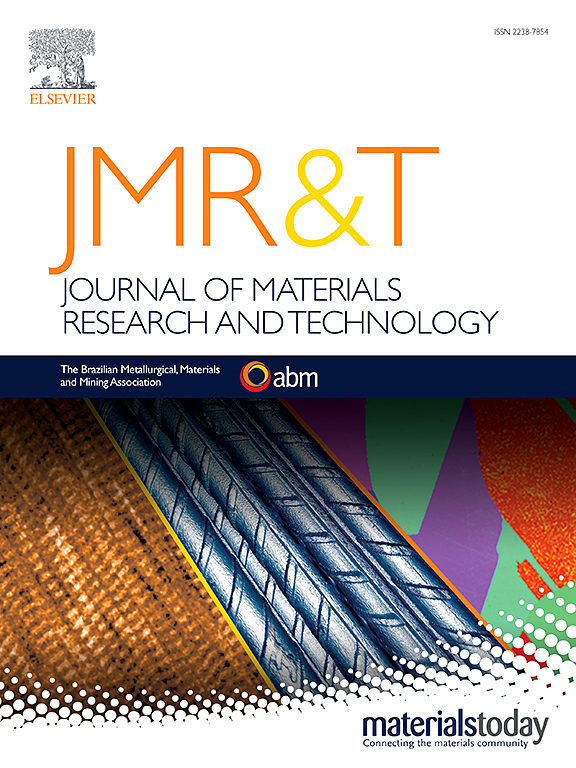FSWed Fe-xAl和Fe-0.1C-xAl合金的组织与力学性能
IF 6.2
2区 材料科学
Q1 MATERIALS SCIENCE, MULTIDISCIPLINARY
Journal of Materials Research and Technology-Jmr&t
Pub Date : 2025-03-17
DOI:10.1016/j.jmrt.2025.03.140
引用次数: 0
摘要
研究了FSWed Fe-(0.05, 2,5)Al和Fe-0.1 c -(0.05, 5)Al钢的微观组织演变和力学性能。在FSW前,对热轧带进行700℃热处理30 min。相图计算、EDS、TEM和SEM-EBSD分析证实了Fe-0.1C-0.05Al中存在渗碳体(Fe3C,正交晶型),Fe-0.1C-5Al中存在碳化物(Fe3AlCx, L12钙钛矿型结构)。FSW显著细化了8.6 μm - 4.6 μm的晶粒尺寸,改变了碳化物的形貌。在此过程中,BM中的粗渗碳体破碎成较小的颗粒,BM中的κ-碳化物转变为较小的κ-碳化物,并在晶界处形成极小的渗碳体。较高的Al和C含量主要通过晶粒细化、固溶和析出强化来协同强化SZs。在Fe-xAl合金中,随着Al含量的增加,SZs的伸长率降低,而在Fe-0.1C-xAl合金中,当Al含量为5 wt%时,SZs的伸长率提高。随着Al含量的增加,材料的韧脆转变温度(DBTT)和上架能均呈上升趋势。与5 wt% Al合金相比,添加0.1 wt% C时,0.05 wt% Al合金的DBTT增量要大得多。这些延展性和韧性的变化是由于添加5%的Al后碳化物的变化。在DBTT以下,Fe-0.1C-0.05Al合金的裂纹在渗碳体内部萌生并扩展为铁素体,而Fe-0.1C-5Al合金的裂纹虽然存在κ碳化物和细渗碳体,但裂纹仍形成并扩展为铁素体基体。本文章由计算机程序翻译,如有差异,请以英文原文为准。

Microstructures and mechanical properties of FSWed Fe-xAl and Fe-0.1C-xAl alloys
The microstructural evolution and mechanical properties of SZs of FSWed Fe-(0.05, 2, 5)Al and Fe-0.1C-(0.05, 5)Al steels were investigated. The hot rolled bands were heat-treated at 700 °C for 30 min prior to FSW. Phase diagram calculations, along with EDS, TEM, and Kikuchi pattern analyses by SEM-EBSD, confirmed the presence of cementite (Fe3C, Orthorhombic) in Fe-0.1C-0.05Al and κ-carbides (Fe3AlCx, L12 perovskite-type structure) in Fe-0.1C-5Al. FSW significantly refined grain sizes of 8.6 μm–4.6 μm and altered carbide morphologies. During the process, coarse cementites in BM were fragmented into smaller particles, while κ-carbides in the BM changed to smaller κ-carbides together with very small cementites at grain boundaries. Higher Al and C contents synergistically strengthened SZs mainly through grain refinement, solid solution, and precipitation strengthening. Specifically, the elongation of the SZs decreased with increasing Al content in Fe-xAl alloys, whereas it increased with the addition of 5 wt% Al in Fe-0.1C-xAl alloys. Furthermore, both the ductile-brittle transition temperature (DBTT) and upper shelf energy increased with Al content. The DBTT increment with 0.1 wt% C addition was much larger in the 0.05 wt% Al alloys compared to the 5 wt% Al alloys. These features of ductility and toughness of the SZs are attributed to the changes in carbides with the 5 wt% Al addition. Below the DBTT, cracks in the Fe-0.1C-0.05Al alloy initiated within cementite and propagated into ferrite, while in the Fe-0.1C-5Al alloy, cracks formed and propagated into the ferrite matrix despite the presence of κ-carbides and fine cementite.
求助全文
通过发布文献求助,成功后即可免费获取论文全文。
去求助
来源期刊

Journal of Materials Research and Technology-Jmr&t
Materials Science-Metals and Alloys
CiteScore
8.80
自引率
9.40%
发文量
1877
审稿时长
35 days
期刊介绍:
The Journal of Materials Research and Technology is a publication of ABM - Brazilian Metallurgical, Materials and Mining Association - and publishes four issues per year also with a free version online (www.jmrt.com.br). The journal provides an international medium for the publication of theoretical and experimental studies related to Metallurgy, Materials and Minerals research and technology. Appropriate submissions to the Journal of Materials Research and Technology should include scientific and/or engineering factors which affect processes and products in the Metallurgy, Materials and Mining areas.
 求助内容:
求助内容: 应助结果提醒方式:
应助结果提醒方式:


